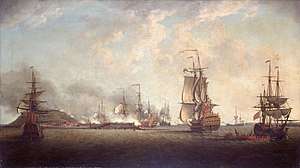HMS Nassau (1706)
HMS Nassau was a 70-gun third rate ship of the line of the Royal Navy, built at Portsmouth Dockyard and launched on 9 January 1706.[1]
_RMG_J3126.png) Plan of the 1740 rebuild of Nassau | |
| History | |
|---|---|
| Name: | HMS Nassau |
| Builder: | Portsmouth Dockyard |
| Launched: | 9 January 1706 |
| Fate: | Sold, 1770 |
| General characteristics as built[1] | |
| Class and type: | 70-gun third rate ship of the line |
| Tons burthen: | 1104 tons BM |
| Length: | 150 ft 6 in (45.9 m) (gundeck) |
| Beam: | 41 ft (12.5 m) |
| Depth of hold: | 17 ft 4 in (5.3 m) |
| Propulsion: | Sails |
| Sail plan: | Full rigged ship |
| Armament: | 70 guns of various weights of shot |
| General characteristics after 1740 rebuild[2] | |
| Class and type: | 1733 proposals 70-gun third rate ship of the line |
| Tons burthen: | 1225 tons BM |
| Length: | 151 ft (46.0 m) (gundeck) |
| Beam: | 43 ft 5 in (13.2 m) |
| Depth of hold: | 17 ft 9 in (5.4 m) |
| Propulsion: | Sails |
| Sail plan: | Full rigged ship |
| Complement: | 410-480[3] |
| Armament: |
|
Orders were issued on 25 May 1736 directing Nassau to be taken to pieces and rebuilt according to the 1733 proposals of the 1719 Establishment at Chatham, from where she was relaunched on 25 September 1740.[2]
In February 1747 Nassau was listed as under the command of Captain Holcombe.[3] In May of that year, Nassau captured on passage from Corsica to Genoa two troop transports carrying 210 Spanish and French soldiers and officers.[4]
Nassau was sold out of the navy in 1770.[2]
Notes
- Lavery, Ships of the Line vol.1, p166.
- Lavery, Ships of the Line vol.1, p171.
- "A General List of His Majesty's Royal Navy". The Scots Magazine. British Newspaper Archive. 6 February 1747. p. 94. Retrieved 6 June 2017.
- "From the London Gazette". Derby Mercury. British Newspaper Archive. 8 May 1747. Retrieved 6 June 2017.
gollark: No, it does.
gollark: - PotatOS uses a single global process manager instance for nested potatOS instances. The ID is incremented by 1 each time a new process starts.- But each nested instance runs its own set of processes, because I never made them not do that and because without *some* of them things would break.- PotatOS has a "fast reboot" feature where, if you reboot in the sandbox, instead of *actually* rebooting the computer it just reinitializes the sandbox a bit.- For various reasons (resource exhaustion I think, mostly), if you nest it, stuff crashes a lot. This might end up causing some of the nested instances to reboot.- When they reboot, some of their processes many stay online because I never added sufficient protections against that because it never really came up.- The slowness is because each event goes to about 200 processes which then maybe do things.
gollark: WRONG!
gollark: It doesn't reuse already allocated IDs.
gollark: Don't read too much into that.
References
- Lavery, Brian (2003) The Ship of the Line - Volume 1: The development of the battlefleet 1650-1850. Conway Maritime Press. ISBN 0-85177-252-8.
This article is issued from Wikipedia. The text is licensed under Creative Commons - Attribution - Sharealike. Additional terms may apply for the media files.
